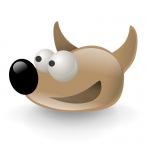 Gimp is an acronym for the GNU Image Manipulation Program.
Gimp is an acronym for the GNU Image Manipulation Program.
It is a free, open source raster image editor available on multiple operating platforms (Windows, Linux, OS X, etc.)
Gimp features a customizable interface, photo enhancement and digital retouching features, as well as support for multiple hardware devices and file formats.
It is expandable by way of plugins and extensions that can be added or created via its scripting interface.
As a cross-platform image-editor, Gimp is unparalleled.
Gimp vs. Photoshop
As much as I think of it as such, Gimp is not generally considered an “alternative” to Photoshop.
It is, however, widely regarded as Linux’s solution to the fact that Photoshop is not available on Linux platforms.
There are many differences between the two programs, despite their similarities.
Gimp’s price tag ($0) weights heavily in it’s favor, at least for those of us who are not professional graphic designers whose job justifies Photoshop’s monthly price tag.
In addition, although Gimp was first released only 6 years after Photoshop, Photoshop grew in popularity much more quickly, resulting in a greater pool of resources (plugins/extensions/etc.) and community support.
In short, if you’re a long-time Photoshop user, don’t ditch it just yet, but anyone interested in basic image design and editing should find that Gimp meets their needs quite sufficiently.
History
Gimp was developed in 1995 by Spencer Kimball and Peter Mattis, two students at the Berkeley University of California.
They first named it the General Image Manipulation Program, before changing its name to the GNU Image Manipulation Program in 1997.
Gimp version 1.0 was released in June of 1998.
As of February 2017, the latest stable version of Gimp is/was 2.8.20.
The Gimp mascot, as seen in the beginning of the post, is named Wilber.
Installation
Gimp comes packaged together with most distributions of Linux, making installation unnecessary.
For Windows, Gimp can be downloaded and installed much like any other program (click Next > Next > Etc.)
Summary
This begins a series that will take us through some basic image creation/editing (maybe/hopefully?) by way of exploring the gimp features and functions.
See you in two weeks!
